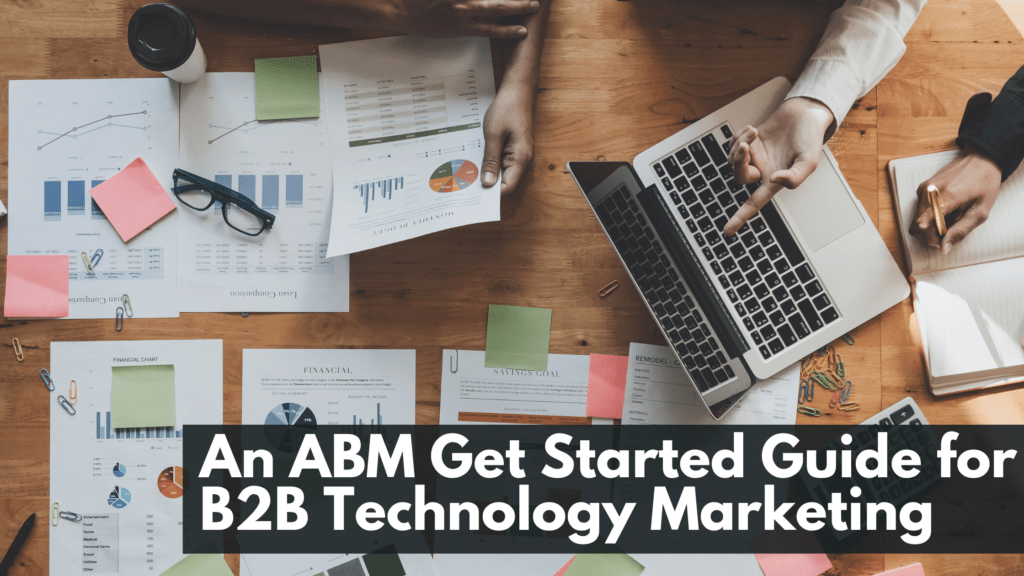If you’re new to the concept of ABM, allow us to use a little fishing analogy: inbound marketing is casting a net. Account-based marketing (ABM) is spearfishing.
The nature of inbound marketing is that you don’t know exactly who you’ll sell to. You may have a general idea (where you’ll throw your net), but your campaign is primarily designed to put content out in the abyss so that potential buyers–whomever they may be–can find it and respond to it. In ABM, your approach is targeted. You’ve already identified the specific accounts you want to sell to, and your campaign is designed to deliver your content directly to these accounts. Spear–fish–BOOM.
Truth time: if you’re a niche B2B tech firm with a small pool of potential clients, you should be focusing on ABM instead of inbound marketing. Even if your business has a broader audience, you should seriously consider an ABM campaign if you’re selling a specific service offering or selling to a specific geography that narrows your pool.
ABM has some unique benefits. First, it reaches a pre-qualified audience. Since you identified specific accounts that you assessed would be great clients, you’re not wasting time on misaligned prospects (AKA catching dolphins in your net). Second, ABM allows for your message to be deeply personalized. Because they’re so targeted, ABM campaigns can include many personalization points (first name, company name, location, etc.) in messaging components like emails, landing pages, and even videos. Third, an ABM campaign incorporates multiple touch points, which are sure to resonate with your targeted audience. Once you’ve selected your ideal accounts, you can engage them with consistent, effective marketing to drive conversions.
Okay – now that we’ve convinced you that launching an ABM campaign is the best idea since sliced bread, what’s next? If you think this could be an effective play in your B2B tech marketing strategy, how do you tactically run the campaign?
We’ve got you covered. Let’s walk through five basic steps in a standard ABM campaign.
1. Make a list. Check it twice.
Logically, you should start your ABM campaign by identifying your target accounts.
In other words, qualify your ideal buyers and then get a list of them to target. What kind of companies are you hoping to work with? Think through factors like company size (revenue, number of employees, number of offices), job title, geographic location, etc. Putting together ideal client personas can be useful here. If you’ve been in the biz for a while, you may already have an existing database of these people, built through years of developing relationships or organic list building. That’s a major step that can make this process way easier. If this is your case…move on to stage two, you’re a step ahead.
If (like most people) you don’t have a list of your target accounts, it’s time to buy one. While buying lists is not ideal most of the time, there are certain times when it makes sense – and an ABM campaign is one of those rare times.
With that said, take precautions and do it right! Define your parameters effectively and get a list from a good, reputable source. Otherwise, you’ll be marketing to a list of unresponsive or non-existent contacts – basically, you’ll be shouting repeatedly at a brick wall (or throwing your net in an empty pool). It goes without saying that this is not a good approach to B2B tech marketing.
2. Create a Drip Campaign.
This has nothing to do with coffee (but go get yourself a cuppa, we’ll wait.)
Once you have your curated list of ideal buyers in hand, it’s time to start creating the targeted content and messaging you’ll reach them with. \
There are plenty of channels you can choose, but let’s keep things simple. Let’s stick with the most common: email drip. Depending on the nature of your audience, you might also work in direct mail sends, voicemails, paid ads, or in-person high-fives (or elbow-fives in this climate).
Email Drip
An email drip is a series of email sent to the same list over a designated period of time. Like the dripping of a tap, you keep a slow but steady stream of contact with the prospects on your list. There are different frameworks you can build out, but we’ve found this messaging series to be particularly effective.
- Identify Your Buyers’ Pain Points
In the first email, show your audience that you get what they’re going through. Focus on the pain points you expect this target to have. You can include a soft nod to your offering, but don’t make it the focus. Slow and steady wins the race here.
- Introduce Your Solution
In your second email, bring your offering to the forefront. Talk about how your offering solves the pain points you identified in your previous email. Show how it will make your target buyer’s life better. Easy does it.
- Provide a Case Study or Testimonial
In the third email, offer your prospect a concrete example of success to build credibility and confidence. The best way to do this is by combining case studies with quotes, but work with what you’ve got. If, for whatever reason, you don’t have case studies or testimonials yet, this email should still seek to build confidence; you’ll just need to get creative (and make a good argument).
- Address Buying Objections and Offer Rebuttals
Speaking of arguments, your fourth email’s where you really get into it (in a pleasant, friendly, and expert way, of course. You catch more bees with honey, as they say). In this email, bring up all the potential reasons you can think of that this person hasn’t become a client, and then offer a rebuttal to each one. Don’t be disingenuous; tackle the real issues, and be willing to admit the scope of any obstacles. But clearly position the benefits of your offering.
- Send a Final Sales Message
This is the last shot. Send your prospect one final solid pitch for your solution. You can bring in whatever is most compelling – more testimonials, pain points, or benefits. Make your case as strongly as you can.
3. Build Out a Landing Page.
If you followed Step 2, then you’ve got a messaging drip built out. Now, you need a place for your target buyers to go if they want to learn more about your offering.
Ready? It’s time to build a landing page.
You may have multiple landing pages built into your ABM campaign; you’ll certainly have at least one. Components of a highly effective landing page include:
- A clear, high-level definition of your product or service. What you’re offering should be immediately obvious.
- The stakes of the sale. What clients will get and what non-clients miss out on should be obvious, too.
- Your customer’s pain points. Your page should reiterate the challenges your target faces in ways that show you understand.
- How your solution helps. You should include some overview of features and benefits.
- Social proof. Testimonials, case studies, and brand logo banners prove your offering is successful.
- Conversion points. You should give users a clear next step when they hit the page.
4. Set Up Remarketing.
Once users hit your landing page, it’s prime time to retarget them with targeted ads to reinforce interest and remain at the top of their mind.
The simplest and most straightforward approach to this is to run Google Display ads to all the viewers who have hit your landing page. (You’ll need at least 100 active visitors within the last 30 days, so if your list is very small, this may not be an option. Do what works for you, Boo.) If you do this well, it will allow you to follow your accounts around the web with messaging that continues the conversation from your email and voicemail touch points. You can reiterate messaging from your previous marketing, but ideally you should build and expand on it. Every message should add value in a new way.
In short, the idea of running remarketing is to continue building touch points and messaging to stay connected with your list.
5. Launch and track.
Finally, with your list bought and your messaging planned, it’s time to turn all systems to GO on your finely-tuned ABM campaign. From here on out, your job will be to monitor results closely and take action to close leads when your prospects “bite” (that’s right, we’re still using the fishing analogy).
It’s critical to have your sales team primed for this. You may want to set up lead scoring automation to alert sales to campaign activity. For instance, if a prospect clicks a link in your email and hits your landing page but doesn’t convert, it may (depending on your campaign) make sense to have sales follow up with a quick phone call to talk through any objections in real time. The important thing is to be ready to respond and act quickly.
Be ready to crush it when you launch your campaign. When it concludes, dig into the data to see how your marketing resonated. Take those results, make optimizations, and position your marketing more effectively for subsequent campaigns.
We hope that this framework has been informative and useful to you as a B2B tech business. ABM is a powerful marketing tool when applied to the right context and executed in the right way. Godspeed and good luck!
Are you thinking about using ABM in your B2B tech marketing plan? With MKC Agency, you get a kickass team of dedicated, experienced professionals who are equipped to craft effective marketing campaigns and get you the leads you want. Give us a shout, and we can start working together to meet your unique business needs.

